lock FIAT DOBLO COMBI 2017 2.G User Guide
[x] Cancel search | Manufacturer: FIAT, Model Year: 2017, Model line: DOBLO COMBI, Model: FIAT DOBLO COMBI 2017 2.GPages: 300, PDF Size: 24.91 MB
Page 29 of 300
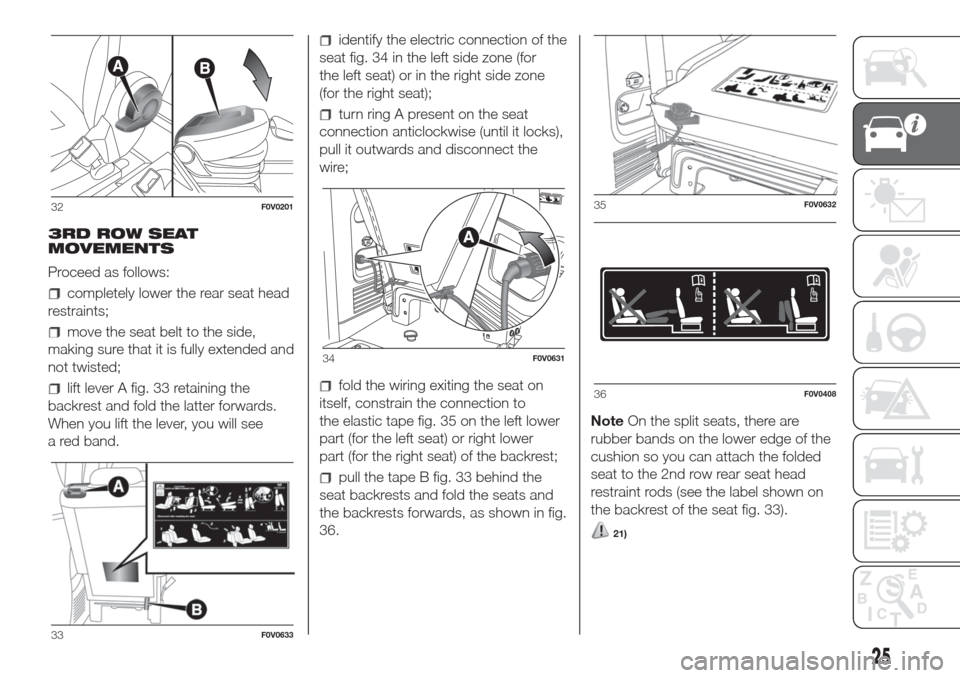
3RD ROW SEAT
MOVEMENTS
Proceed as follows:
completely lower the rear seat head
restraints;
move the seat belt to the side,
making sure that it is fully extended and
not twisted;
lift lever A fig. 33 retaining the
backrest and fold the latter forwards.
When you lift the lever, you will see
a red band.
identify the electric connection of the
seat fig. 34 in the left side zone (for
the left seat) or in the right side zone
(for the right seat);
turn ring A present on the seat
connection anticlockwise (until it locks),
pull it outwards and disconnect the
wire;
fold the wiring exiting the seat on
itself, constrain the connection to
the elastic tape fig. 35 on the left lower
part (for the left seat) or right lower
part (for the right seat) of the backrest;
pull the tape B fig. 33 behind the
seat backrests and fold the seats and
the backrests forwards, as shown in fig.
36.NoteOn the split seats, there are
rubber bands on the lower edge of the
cushion so you can attach the folded
seat to the 2nd row rear seat head
restraint rods (see the label shown on
the backrest of the seat fig. 33).
21)
32F0V0201
33F0V0633
34F0V0631
35F0V0632
36F0V0408
25
Page 30 of 300
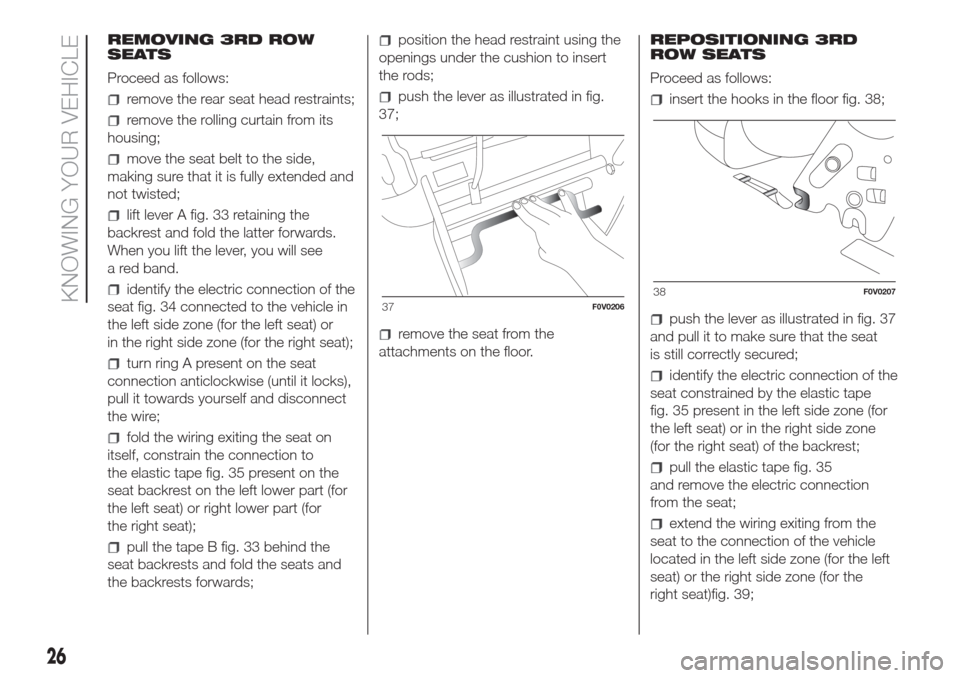
REMOVING 3RD ROW
SEATS
Proceed as follows:
remove the rear seat head restraints;
remove the rolling curtain from its
housing;
move the seat belt to the side,
making sure that it is fully extended and
not twisted;
lift lever A fig. 33 retaining the
backrest and fold the latter forwards.
When you lift the lever, you will see
a red band.
identify the electric connection of the
seat fig. 34 connected to the vehicle in
the left side zone (for the left seat) or
in the right side zone (for the right seat);
turn ring A present on the seat
connection anticlockwise (until it locks),
pull it towards yourself and disconnect
the wire;
fold the wiring exiting the seat on
itself, constrain the connection to
the elastic tape fig. 35 present on the
seat backrest on the left lower part (for
the left seat) or right lower part (for
the right seat);
pull the tape B fig. 33 behind the
seat backrests and fold the seats and
the backrests forwards;
position the head restraint using the
openings under the cushion to insert
the rods;
push the lever as illustrated in fig.
37;
remove the seat from the
attachments on the floor.REPOSITIONING 3RD
ROW SEATS
Proceed as follows:
insert the hooks in the floor fig. 38;
push the lever as illustrated in fig. 37
and pull it to make sure that the seat
is still correctly secured;
identify the electric connection of the
seat constrained by the elastic tape
fig. 35 present in the left side zone (for
the left seat) or in the right side zone
(for the right seat) of the backrest;
pull the elastic tape fig. 35
and remove the electric connection
from the seat;
extend the wiring exiting from the
seat to the connection of the vehicle
located in the left side zone (for the left
seat) or the right side zone (for the
right seat)fig. 39;
37F0V020638F0V0207
26
KNOWING YOUR VEHICLE
Page 31 of 300
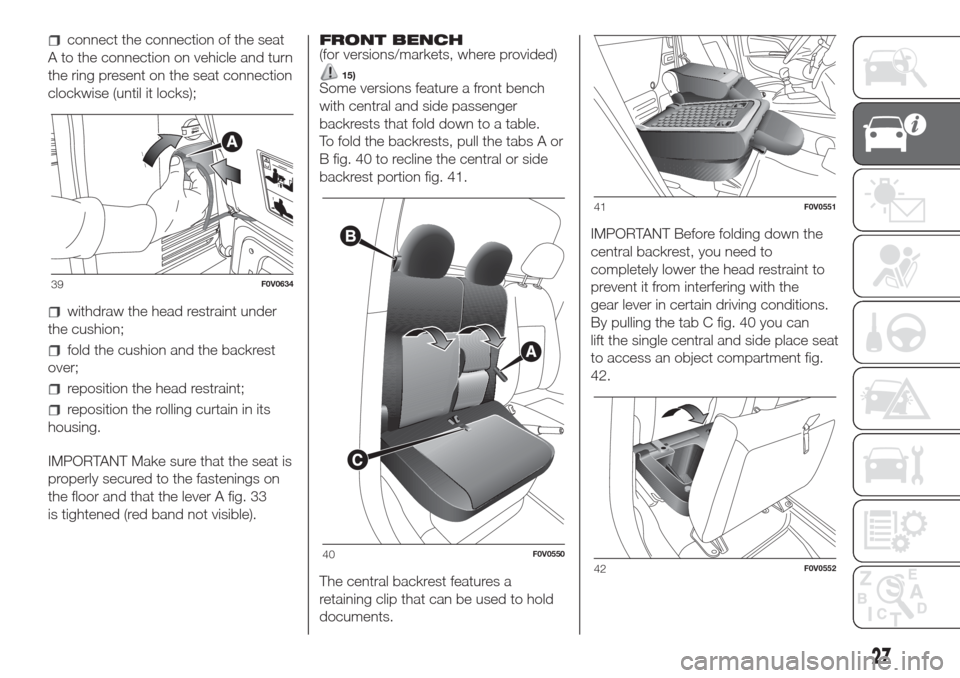
connect the connection of the seat
A to the connection on vehicle and turn
the ring present on the seat connection
clockwise (until it locks);
withdraw the head restraint under
the cushion;
fold the cushion and the backrest
over;
reposition the head restraint;
reposition the rolling curtain in its
housing.
IMPORTANT Make sure that the seat is
properly secured to the fastenings on
the floor and that the lever A fig. 33
is tightened (red band not visible).FRONT BENCH
(for versions/markets, where provided)
15)Some versions feature a front bench
with central and side passenger
backrests that fold down to a table.
To fold the backrests, pull the tabs A or
B fig. 40 to recline the central or side
backrest portion fig. 41.
The central backrest features a
retaining clip that can be used to hold
documents.IMPORTANT Before folding down the
central backrest, you need to
completely lower the head restraint to
prevent it from interfering with the
gear lever in certain driving conditions.
By pulling the tab C fig. 40 you can
lift the single central and side place seat
to access an object compartment fig.
42.
39F0V0634
40F0V0550
41F0V0551
42F0V0552
27
Page 32 of 300
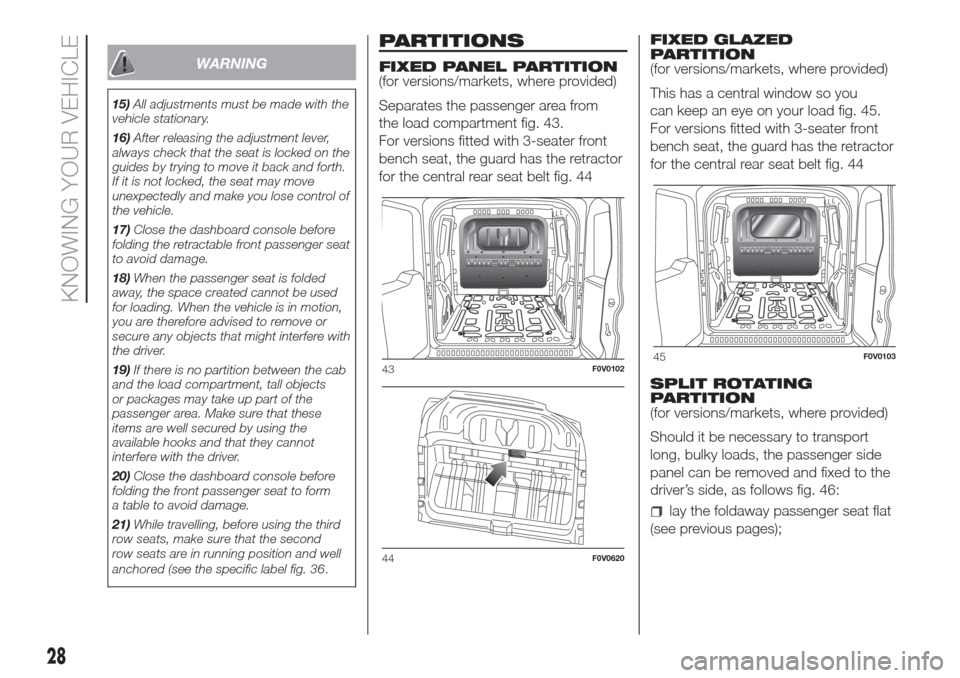
WARNING
15)All adjustments must be made with the
vehicle stationary.
16)After releasing the adjustment lever,
always check that the seat is locked on the
guides by trying to move it back and forth.
If it is not locked, the seat may move
unexpectedly and make you lose control of
the vehicle.
17)Close the dashboard console before
folding the retractable front passenger seat
to avoid damage.
18)When the passenger seat is folded
away, the space created cannot be used
for loading. When the vehicle is in motion,
you are therefore advised to remove or
secure any objects that might interfere with
the driver.
19)If there is no partition between the cab
and the load compartment, tall objects
or packages may take up part of the
passenger area. Make sure that these
items are well secured by using the
available hooks and that they cannot
interfere with the driver.
20)Close the dashboard console before
folding the front passenger seat to form
a table to avoid damage.
21)While travelling, before using the third
row seats, make sure that the second
row seats are in running position and well
anchored (see the specific label fig. 36.
PARTITIONS
FIXED PANEL PARTITION
(for versions/markets, where provided)
Separates the passenger area from
the load compartment fig. 43.
For versions fitted with 3-seater front
bench seat, the guard has the retractor
for the central rear seat belt fig. 44FIXED GLAZED
PARTITION
(for versions/markets, where provided)
This has a central window so you
can keep an eye on your load fig. 45.
For versions fitted with 3-seater front
bench seat, the guard has the retractor
for the central rear seat belt fig. 44
SPLIT ROTATING
PARTITION
(for versions/markets, where provided)
Should it be necessary to transport
long, bulky loads, the passenger side
panel can be removed and fixed to the
driver’s side, as follows fig. 46:
lay the foldaway passenger seat flat
(see previous pages);
43F0V0102
44F0V0620
45F0V0103
28
KNOWING YOUR VEHICLE
Page 33 of 300
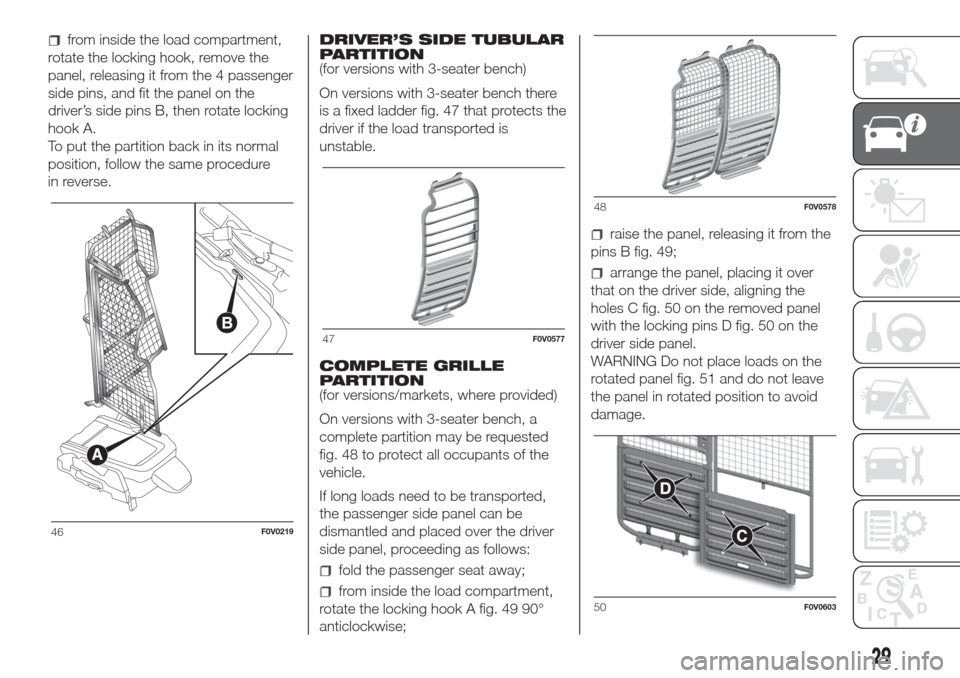
from inside the load compartment,
rotate the locking hook, remove the
panel, releasing it from the 4 passenger
side pins, and fit the panel on the
driver’s side pins B, then rotate locking
hook A.
To put the partition back in its normal
position, follow the same procedure
in reverse.DRIVER’S SIDE TUBULAR
PARTITION
(for versions with 3-seater bench)
On versions with 3-seater bench there
is a fixed ladder fig. 47 that protects the
driver if the load transported is
unstable.
COMPLETE GRILLE
PARTITION
(for versions/markets, where provided)
On versions with 3-seater bench, a
complete partition may be requested
fig. 48 to protect all occupants of the
vehicle.
If long loads need to be transported,
the passenger side panel can be
dismantled and placed over the driver
side panel, proceeding as follows:
fold the passenger seat away;
from inside the load compartment,
rotate the locking hook A fig. 49 90°
anticlockwise;
raise the panel, releasing it from the
pins B fig. 49;
arrange the panel, placing it over
that on the driver side, aligning the
holes C fig. 50 on the removed panel
with the locking pins D fig. 50 on the
driver side panel.
WARNING Do not place loads on the
rotated panel fig. 51 and do not leave
the panel in rotated position to avoid
damage.
46F0V0219
47F0V0577
48F0V0578
50F0V0603
29
Page 34 of 300

HEAD RESTRAINTS
FRONT
The head restraints are height-
adjustable and lock into the desired
position automatically.
Adjustment
upward adjustment: raise the head
restraint until it clicks into place.
downwards adjustment: press
button A fig. 52 - fig. 53 and lower the
head restraint.
22) 23)
REAR
(for versions/markets, where provided)
To use them, lift them up.
To put them away, press buttons A fig.
54and push the head restraints down
into the backrest.
To extract the head restraints, raise
them until you hear the click (which
indicates they are in the position of
use).
IMPORTANT If the rear seats are used,
always set the head restraints in the
"completely raised" position.
49F0V0602
51F0V0604
52F0V0105
53 - Front bench versionF0V0553
54F0V0119
30
KNOWING YOUR VEHICLE
Page 35 of 300
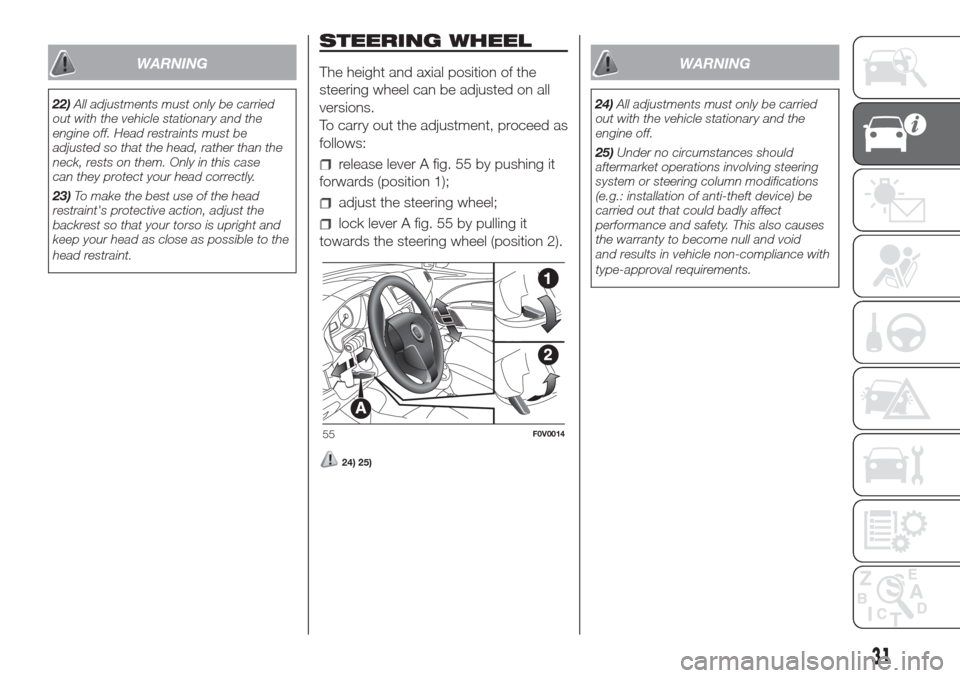
WARNING
22)All adjustments must only be carried
out with the vehicle stationary and the
engine off. Head restraints must be
adjusted so that the head, rather than the
neck, rests on them. Only in this case
can they protect your head correctly.
23)To make the best use of the head
restraint's protective action, adjust the
backrest so that your torso is upright and
keep your head as close as possible to the
head restraint.
STEERING WHEEL
The height and axial position of the
steering wheel can be adjusted on all
versions.
To carry out the adjustment, proceed as
follows:
release lever A fig. 55 by pushing it
forwards (position 1);
adjust the steering wheel;
lock lever A fig. 55 by pulling it
towards the steering wheel (position 2).
24) 25)
WARNING
24)All adjustments must only be carried
out with the vehicle stationary and the
engine off.
25)Under no circumstances should
aftermarket operations involving steering
system or steering column modifications
(e.g.: installation of anti-theft device) be
carried out that could badly affect
performance and safety. This also causes
the warranty to become null and void
and results in vehicle non-compliance with
type-approval requirements.
55F0V0014
31
Page 36 of 300
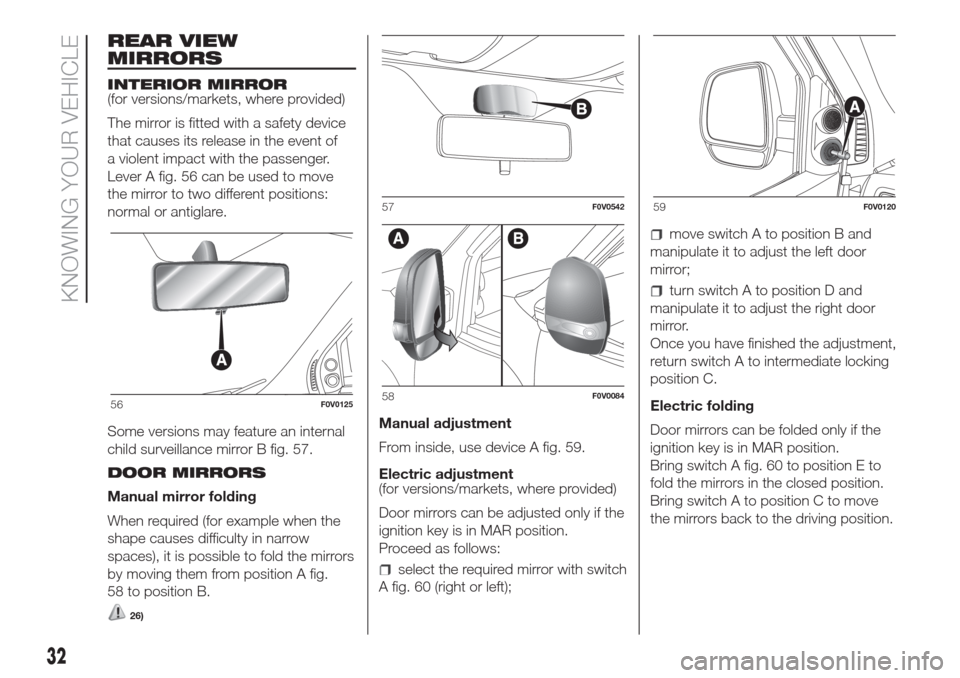
REAR VIEW
MIRRORS
INTERIOR MIRROR
(for versions/markets, where provided)
The mirror is fitted with a safety device
that causes its release in the event of
a violent impact with the passenger.
Lever A fig. 56 can be used to move
the mirror to two different positions:
normal or antiglare.
Some versions may feature an internal
child surveillance mirror B fig. 57.
DOOR MIRRORS
Manual mirror folding
When required (for example when the
shape causes difficulty in narrow
spaces), it is possible to fold the mirrors
by moving them from position A fig.
58 to position B.
26)
Manual adjustment
From inside, use device A fig. 59.
Electric adjustment
(for versions/markets, where provided)
Door mirrors can be adjusted only if the
ignition key is in MAR position.
Proceed as follows:
select the required mirror with switch
A fig. 60 (right or left);
move switch A to position B and
manipulate it to adjust the left door
mirror;
turn switch A to position D and
manipulate it to adjust the right door
mirror.
Once you have finished the adjustment,
return switch A to intermediate locking
position C.
Electric folding
Door mirrors can be folded only if the
ignition key is in MAR position.
Bring switch A fig. 60 to position E to
fold the mirrors in the closed position.
Bring switch A to position C to move
the mirrors back to the driving position.
56F0V0125
57F0V0542
58F0V0084
59F0V0120
32
KNOWING YOUR VEHICLE
Page 54 of 300
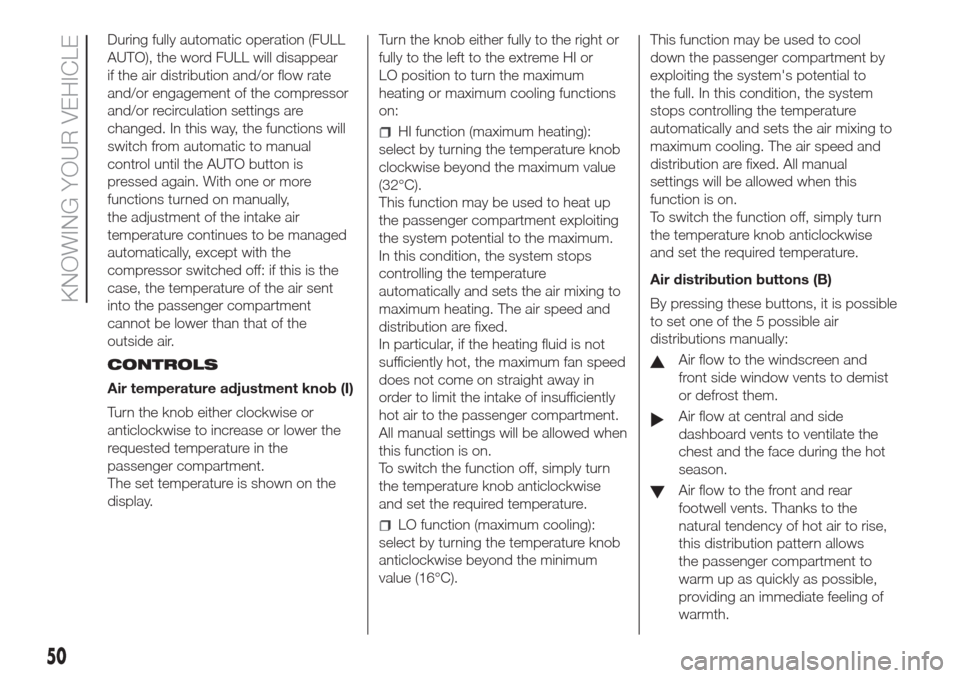
During fully automatic operation (FULL
AUTO), the word FULL will disappear
if the air distribution and/or flow rate
and/or engagement of the compressor
and/or recirculation settings are
changed. In this way, the functions will
switch from automatic to manual
control until the AUTO button is
pressed again. With one or more
functions turned on manually,
the adjustment of the intake air
temperature continues to be managed
automatically, except with the
compressor switched off: if this is the
case, the temperature of the air sent
into the passenger compartment
cannot be lower than that of the
outside air.
CONTROLS
Air temperature adjustment knob (I)
Turn the knob either clockwise or
anticlockwise to increase or lower the
requested temperature in the
passenger compartment.
The set temperature is shown on the
display.Turn the knob either fully to the right or
fully to the left to the extreme HI or
LO position to turn the maximum
heating or maximum cooling functions
on:
HI function (maximum heating):
select by turning the temperature knob
clockwise beyond the maximum value
(32°C).
This function may be used to heat up
the passenger compartment exploiting
the system potential to the maximum.
In this condition, the system stops
controlling the temperature
automatically and sets the air mixing to
maximum heating. The air speed and
distribution are fixed.
In particular, if the heating fluid is not
sufficiently hot, the maximum fan speed
does not come on straight away in
order to limit the intake of insufficiently
hot air to the passenger compartment.
All manual settings will be allowed when
this function is on.
To switch the function off, simply turn
the temperature knob anticlockwise
and set the required temperature.
LO function (maximum cooling):
select by turning the temperature knob
anticlockwise beyond the minimum
value (16°C).This function may be used to cool
down the passenger compartment by
exploiting the system's potential to
the full. In this condition, the system
stops controlling the temperature
automatically and sets the air mixing to
maximum cooling. The air speed and
distribution are fixed. All manual
settings will be allowed when this
function is on.
To switch the function off, simply turn
the temperature knob anticlockwise
and set the required temperature.
Air distribution buttons (B)
By pressing these buttons, it is possible
to set one of the 5 possible air
distributions manually:
Air flow to the windscreen and
front side window vents to demist
or defrost them.
Air flow at central and side
dashboard vents to ventilate the
chest and the face during the hot
season.
Air flow to the front and rear
footwell vents. Thanks to the
natural tendency of hot air to rise,
this distribution pattern allows
the passenger compartment to
warm up as quickly as possible,
providing an immediate feeling of
warmth.
50
KNOWING YOUR VEHICLE
Page 58 of 300
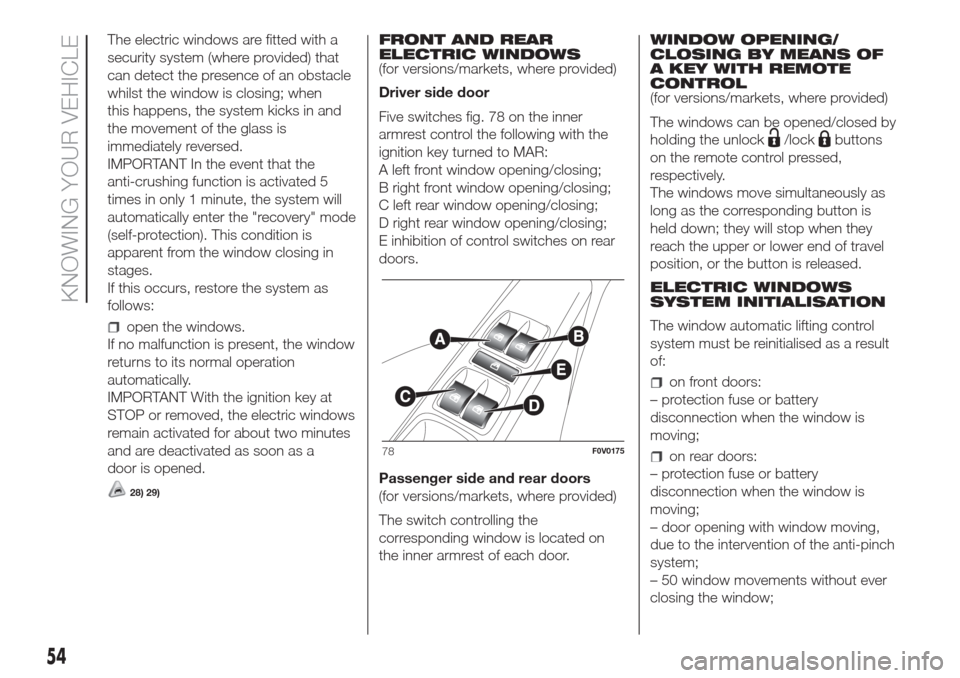
The electric windows are fitted with a
security system (where provided) that
can detect the presence of an obstacle
whilst the window is closing; when
this happens, the system kicks in and
the movement of the glass is
immediately reversed.
IMPORTANT In the event that the
anti-crushing function is activated 5
times in only 1 minute, the system will
automatically enter the "recovery" mode
(self-protection). This condition is
apparent from the window closing in
stages.
If this occurs, restore the system as
follows:
open the windows.
If no malfunction is present, the window
returns to its normal operation
automatically.
IMPORTANT With the ignition key at
STOP or removed, the electric windows
remain activated for about two minutes
and are deactivated as soon as a
door is opened.
28) 29)
FRONT AND REAR
ELECTRIC WINDOWS
(for versions/markets, where provided)
Driver side door
Five switches fig. 78 on the inner
armrest control the following with the
ignition key turned to MAR:
A left front window opening/closing;
B right front window opening/closing;
C left rear window opening/closing;
D right rear window opening/closing;
E inhibition of control switches on rear
doors.
Passenger side and rear doors
(for versions/markets, where provided)
The switch controlling the
corresponding window is located on
the inner armrest of each door.WINDOW OPENING/
CLOSING BY MEANS OF
A KEY WITH REMOTE
CONTROL
(for versions/markets, where provided)
The windows can be opened/closed by
holding the unlock
/lockbuttons
on the remote control pressed,
respectively.
The windows move simultaneously as
long as the corresponding button is
held down; they will stop when they
reach the upper or lower end of travel
position, or the button is released.
ELECTRIC WINDOWS
SYSTEM INITIALISATION
The window automatic lifting control
system must be reinitialised as a result
of:
on front doors:
– protection fuse or battery
disconnection when the window is
moving;
on rear doors:
– protection fuse or battery
disconnection when the window is
moving;
– door opening with window moving,
due to the intervention of the anti-pinch
system;
– 50 window movements without ever
closing the window;78F0V0175
54
KNOWING YOUR VEHICLE